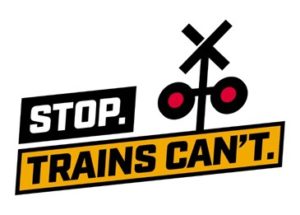
2021 Stop. Trains Can’t.
FACT SHEET
The U.S. Department of Transportation’s National Highway Traffic Safety Administration (NHTSA), the Federal Railroad Administration (FRA) and the Federal Transit Administration (FTA) are teaming up once again for the Stop. Trains Can’t. safety campaign to remind drivers to stop at railroad crossings. The campaign, which begins March 22, 2021 aims to help reduce collisions, deaths, and injuries at railroad crossings, which occur approximately every four hours in the United States. Given a train’s size, weight, and mass, it takes a train a long time to stop, even in an emergency. It is for this reason that, by law, trains always have the right of way and, ultimately, it is the driver’s responsibility to avoid a collision. Read on for more safety tips and facts.
- In 2019 alone, 126 people were killed and 635 people were injured in collisions at railroad crossings. From 2014-2019, there were 798 fatalities involving motor vehicles at railroad crossings.
- Although highway-rail crossing incidents and fatalities declined dramatically for decades, too many drivers circumnavigate lowered gates, and this risky behavior has increased in recent years. In 2019, 94 fatal collisions occurred because of drivers who went around a lowered gate, marking a 10-year high.
- From 2015–2019, 1,589 drivers went around a lowered gate and were struck by a train, accounting for 15% of all collisions. These deaths are largely preventable and are caused by risky driving behaviors and poor decision-making.
Trains Always Have the Right of Way
- By law, trains have the right of way at all railroad crossings.
- Trains cannot swerve, stop quickly, or change direction to avert collisions. A train traveling at 55 miles per hour takes a mile or more to stop.
- State highway traffic safety laws require all drivers to slow, yield, or stop until the train has cleared the roadway and it is safe to cross.
- It is illegal in most states to go around a lowered crossing gate or to ignore signs or flashing lights posted at a railroad crossing.
Know the Laws
- Of the 130,200 public railroad crossings in the United States, roughly 54% are equipped with “active” warning devices, such as automated gates, bells, or flashing lights to alert drivers of an approaching train. But 46% of public grade crossings are equipped with “passive” advance warning signs and markings.
- While active warning devices do improve safety at railroad crossings, they do not prevent all collisions. Approximately 60% of all collisions at railroad crossings occur when active warning devices are present and functioning.
- Motorists must come to a complete stop at least 15 feet from the track if: 1) flashing red lights are activated, 2) a crossing gate is lowered, 3) a flagman or law enforcement officer signals you to stop, 4) a stop sign is posted, or 5) a train is clearly visible or a train whistle is audible.
- Ignoring signage or attempting to go around a lowered crossing gate can have deadly consequences. It is never worth risking your life or the lives of your passengers, train crew and passengers, or others nearby by ignoring the law or racing a train.
Use Caution at Every Railroad Crossing
- When approaching a railroad crossing, slow down, look, and listen for a train on the tracks, especially at “passive” crossings.
- Look carefully in both directions before crossing a railroad track — even during the day. Sixty-seven percent of railroad crossing collisions occur in clear weather conditions.
- Do not rely on past experiences to guess when a train is coming. Trains can approach from either direction at any time, especially in locations with multiple tracks.
- Never race a train. Due to optical effects, most people misjudge an approaching train’s speed and distance from the crossing, just as guessing the height or speed of an airplane in the sky is difficult. A train traveling at 55 miles per hour takes a mile or more to stop — the length of 18 football fields or more — after application of the emergency brakes.
- Before driving over a railroad crossing, be certain there is enough room on the other side of the tracks for your vehicle to fully clear the crossing. Be aware that you may need to cross multiple sets of tracks at some railroad crossings.
- Never stop on the railroad tracks. Keep moving once you have entered the crossing, and to avoid stalling, never shift gears on the tracks.
- If your vehicle stalls on a railroad track, quickly move all occupants away from the track and your vehicle at a 45-degree angle. Call the number on the blue Emergency Notification System sign, or, if the sign is not visible to you, dial 911 for help.
For more information, visit www.trafficsafetymarketing.gov/get-materials/rail-grade-crossing.